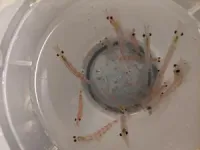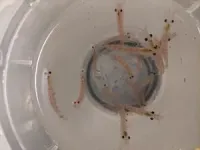(Press-News.org) Imagine looking at the world through the stalked compound eyes of krill in the Southern Ocean. All of a sudden, a penguin appears like a voracious giant, streamlined like a torpedo, chasing and consuming thousands of krill at rapid speed.
Now, researchers have shown that the water-borne smell of the poo of these flightless birds is enough to cause the krill to show escape behaviors.
“Here we show for the first time that a small amount of penguin guano causes a sudden change in the feeding and swimming behaviors of Antarctic krill,” said Dr Nicole Hellessey, a postdoctoral researcher at the Bigelow Laboratory for Ocean Sciences in Maine, and the corresponding author of a new study in Frontiers in Marine Science.
As food for a plethora of species and massive sequesterers of carbon, krill are a keystone species in the Antarctic. It is estimated that there are approximately 700 trillion adult Antarctic krill in the Southern Ocean today, but their population is moving further south due to climate change, the loss of sea ice and ocean acidification.
There is something in the water
Zooplankton like krill are sensitive to chemical cues about food, mates, and pollution and adapt their behavior accordingly, and Hellessey et al. wanted to know if krill also do this in response to odors from predators. The authors focused on Adélies, the most southernly breeding species of penguin, as 99.6% of their diet consists of Antarctic krill. An adult Adélie eats up to 1.6 kg of it per day, and the yearly consumption of Antarctic krill by the world’s population of Adélies is approximately 1.5 million tons.
In late 2022, researchers on board the research vessels ‘Laurence M Gould’ and ‘Nathaniel B Palmer’ in Antarctica’s Bransfield Strait trawled for Antarctic krill to take to Palmer Station’s research aquarium. The catch was kept alive in holding tanks on a diet of algal slurry. Bird experts had previously collected 78g of Adélie guano (“Smells like rotten shellfish. Not pleasant to handle,” said Hellessey) from a colony on Torgersen Island off the Antarctic Peninsula near Palmer Station.
To test the krill’s response to guano, the scientists placed six to eight krill per five-minute trial in a flume filled with seawater with a temperature of 1.5°C. The light was dimmed to mimic the intensity typical of a depth of 40 meters, the most productive layer within the Southern Ocean. Water flowed through the flume at a velocity of either 3cm or 5.9cm per second. This flow was fed with one of three kinds of seawater: containing either algae, Adélie poo, or both. In total, they tested each combination of flow velocity and water composition four times.
They recorded the behavior of four individual krill per trial with two automated cameras, and processed these videos to calculate each krill’s 3D position and its speed and direction of swimming throughout the trial.
The results showed that krill typically swam straight upstream, a behavior called rheotaxis. But once in the presence of poo, they changed their behavior dramatically: they varied their swimming speed more, while swimming between 1.2 and 1.5 times faster. They also made three times more turns, over an angle that was on average 1.4 times greater.
In a second set of experiments, the researchers showed that krill reduced their rate of ingesting algae for food by 64% when penguin poo was added to the water, dropping from 12.7 microgram of carbon per hour per krill (or 13% of their body mass) to 4.6 microgram per hour per krill. These results indicate that krill foraged less efficiently in the presence of guano, due to their frequent change of direction.
The authors concluded that this ‘zigzagging’ is an avoidance or escape reaction.
“Such behavior to escape from nearby penguins would greatly increase the krill’s odds of survival. And these odds would increase exponentially in a swarm, if their neighbors could detect the same cues and communicate the danger to each other,” said Hellessey.
Smells like krill kin spirit
But which chemicals within the poo do the krill respond to? This remains to be elucidated.
“We hypothesize that Antarctic krill are avoiding the odor of ground-up krill and fish in the penguins’ guano. We thus expect krill to show similar swimming behaviors and suppressed feeding around seals, whales, and other types of krill predators in Antarctica,” said Hellessey.
“We don't yet know how the ability of krill to sense these chemical cues and their escape behavior towards them might vary when diluted in open waters, or under global warming or ocean acidification conditions. Any changes to krill’s behavior could have major impacts on the future Southern Ocean, as Antarctic krill are a keystone species in this ecosystem.”
END
Mere whiff of penguin poo pushes krill to take frantic evasive action
Antarctic krill swim in fast zigzags in reaction to guano from predators
2025-03-20
ELSE PRESS RELEASES FROM THIS DATE:
Deep in the Mediterranean, in search of quantum gravity
2025-03-20
Quantum gravity is the missing link between general relativity and quantum mechanics, the yet-to-be-discovered key to a unified theory capable of explaining both the infinitely large and the infinitely small. The solution to this puzzle might lie in the humble neutrino, an elementary particle with no electric charge and almost invisible, as it rarely interacts with matter, passing through everything on our planet without consequences.
For this very reason, neutrinos are difficult to detect. However, in rare cases, ...
Parts of the brain that are needed to remember words identified
2025-03-20
The parts of the brain that are needed to remember words, and how these are affected by a common form of epilepsy, have been identified by a team of neurologists and neurosurgeons at UCL.
The new study, published in Brain Communications, found that shrinkage in the front and side of the brain (prefrontal, temporal and cingulate cortices, and the hippocampus) was linked to difficulty remembering words.
The new discovery highlights how the network that is involved in creating and storing word memories is dispersed throughout the brain.
This is particularly crucial for helping to understand conditions such as epilepsy, in which patients may have difficulty with remembering words. ...
Anti-amyloid drug shows signs of preventing Alzheimer’s dementia
2025-03-20
An experimental drug appears to reduce the risk of Alzheimer’s-related dementia in people destined to develop the disease in their 30s, 40s or 50s, according to the results of a study led by the Knight Family Dominantly Inherited Alzheimer Network-Trials Unit (DIAN-TU), which is based at Washington University School of Medicine in St. Louis. The findings suggest – for the first time in a clinical trial – that early treatment to remove amyloid plaques from the brain many years before symptoms arise can delay the onset of Alzheimer’s dementia.
The study is published March 19 in The Lancet Neurology.
The international study ...
Sharing mealtimes with others linked to better wellbeing
2025-03-20
UCL Press Release
Under embargo until Thursday 20th March, 00:01 UK time / Wednesday 19th March, 20:01 Eastern US time
Not peer reviewed | Literature review & data analysis | People
People who share more mealtimes with others are more likely to report higher levels of life satisfaction and wellbeing, finds research led by a UCL academic for the World Happiness Report.
In chapter three of the report, Sharing Meals with Others, the researchers from UCL, University of Oxford, Harvard University and Gallup found that meal sharing as an indicator ...
New DESI results: Evidence mounts for evolving dark energy
2025-03-19
A new analysis of data collected over three years by the Dark Energy Spectroscopic Instrument (DESI) collaboration provides even stronger evidence than the group’s previous datasets that dark energy, long thought to be a “cosmological constant,” might be evolving over time in unexpected ways.
Dr. Mustapha Ishak-Boushaki, professor of physics at The University of Texas at Dallas, is co-chair of the DESI working group that interprets cosmological survey data gathered by the international collaboration, which includes more than 900 researchers ...
New DESI results strengthen hints that dark energy may evolve
2025-03-19
The fate of the universe hinges on the balance between matter and dark energy: the fundamental ingredient that drives its accelerating expansion. New results from the Dark Energy Spectroscopic Instrument (DESI) collaboration use the largest 3D map of our universe ever made to track dark energy’s influence over the past 11 billion years. Researchers see hints that dark energy, widely thought to be a “cosmological constant,” might be evolving over time in unexpected ways.
DESI is an international experiment with more than 900 researchers from over 70 institutions around the world and is managed by the U.S. Department of Energy’s Lawrence Berkeley ...
DESI opens access to the largest 3D map of the universe yet
2025-03-19
The Dark Energy Spectroscopic Instrument (DESI) is mapping millions of celestial objects to better understand dark energy: the mysterious driver of our universe’s accelerating expansion. Today, the DESI collaboration released a new collection of data for anyone in the world to investigate. The dataset is the largest of its kind, with information on 18.7 million objects: roughly 4 million stars, 13.1 million galaxies, and 1.6 million quasars (extremely bright but distant objects powered by supermassive black holes at their cores).
While the experiment’s ...
New study reveals high levels of fusarium mycotoxins in seized cannabis from Arizona and California
2025-03-19
A recent study conducted by researchers from Arizona State University has uncovered alarming levels of Fusarium mycotoxins in illicit cannabis samples seized in Arizona and California.
The study found that 16% of the 118 samples tested positive for harmful mycotoxins, posing potential health risks to consumers. This groundbreaking research highlights the unregulated and dangerous nature of black-market cannabis.
The study, led by Arizona State University professor Maxwell Leung, analyzed cannabis samples obtained between November 2023 and June 2024 from law enforcement seizures. The samples ...
Sleepier during the day? For some older people, it’s linked to twice the dementia risk
2025-03-19
MINNEAPOLIS — For women in their 80s, experiencing increasing sleepiness during the day over a five-year period is associated with double the risk of developing dementia during that time, according to a study published on March 19, 2025, online in Neurology®, the medical journal of the American Academy of Neurology. The study does not prove that daytime sleepiness causes dementia; it only shows an association.
“Sleep is essential for cognitive health, as it allows the brain to rest and rejuvenate, enhancing our ability to think clearly and remember information,” said study author Yue Leng, PhD, of the University of California, San Francisco. “However, ...
Is increased sleepiness in our 80s tied to higher dementia risk?
2025-03-19
A study in Neurology, led by Yue Leng, PhD, and Sasha Milton, followed the sleep patterns of 733 older female participants to see if specific patterns of change were associated with a higher risk of dementia. The participants, whose average age was 83, were monitored by wrist devices that track movement and time spent asleep. They had normal cognition at the start of the study.
What They Discovered
At the end of the study, five years later, 13% had developed dementia. This included 25 participants (8%) with stable sleep patterns, 39 (15%) ...
LAST 30 PRESS RELEASES:
Tracing the quick synthesis of an industrially important catalyst
New software sheds light on cancer’s hidden genetic networks
UT Health San Antonio awarded $3 million in CPRIT grants to bolster cancer research and prevention efforts in South Texas
Third symposium spotlights global challenge of new contaminants in China’s fight against pollution
From straw to soil harmony: International team reveals how biochar supercharges carbon-smart farming
Myeloma: How AI is redrawing the map of cancer care
Manhattan E. Charurat, Ph.D., MHS invested as the Homer and Martha Gudelsky Distinguished Professor in Medicine at the University of Maryland School of Medicine
Insilico Medicine’s Pharma.AI Q4 Winter Launch Recap: Revolutionizing drug discovery with cutting-edge AI innovations, accelerating the path to pharmaceutical superintelligence
Nanoplastics have diet-dependent impacts on digestive system health
Brain neuron death occurs throughout life and increases with age, a natural human protein drug may halt neuron death in Alzheimer’s disease
SPIE and CLP announce the recipients of the 2025 Advanced Photonics Young Innovator Award
Lessons from the Caldor Fire’s Christmas Valley ‘Miracle’
Ant societies rose by trading individual protection for collective power
Research reveals how ancient viral DNA shapes early embryonic development
A molecular gatekeeper that controls protein synthesis
New ‘cloaking device’ concept to shield sensitive tech from magnetic fields
Researchers show impact of mountain building and climate change on alpine biodiversity
Study models the transition from Neanderthals to modern humans in Europe
University of Phoenix College of Doctoral Studies releases white paper on AI-driven skilling to reduce burnout and restore worker autonomy
AIs fail at the game of visual “telephone”
The levers for a sustainable food system
Potential changes in US homelessness by ending federal support for housing first programs
Vulnerability of large language models to prompt injection when providing medical advice
Researchers develop new system for high-energy-density, long-life, multi-electron transfer bromine-based flow batteries
Ending federal support for housing first programs could increase U.S. homelessness by 5% in one year, new JAMA study finds
New research uncovers molecular ‘safety switch’ shielding cancers from immune attack
Bacteria resisting viral infection can still sink carbon to ocean floor
Younger biological age may increase depression risk in older women during COVID-19
Bharat Innovates 2026 National Basecamp Showcases India’s Most Promising Deep-Tech Ventures
Here’s what determines whether your income level rises or falls
[Press-News.org] Mere whiff of penguin poo pushes krill to take frantic evasive actionAntarctic krill swim in fast zigzags in reaction to guano from predators








